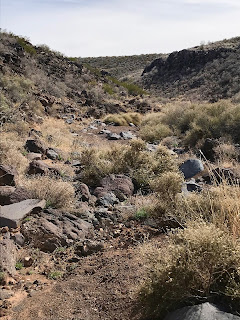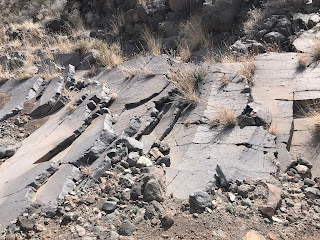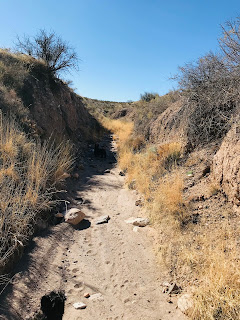Potrillo Mountains Wilderness - Organ Mountains-Desert Peaks National Monument
The cholla, which does well out here, has grown fat and happy with the winter rain and snow. Weeds are beginning to green up the red sands.
 The walking is pretty easy on the softened soil despite all the black rocks. They only sink in a bit, instead of pushing back. From the end of the cherry stemmed road we have headed out to the northwest. Crossing one larger arroyo with tan sand, low black cliffs and gray basalt bedrock, we climb up a low ridge toward a pile of contorted, lichen stained rocks that are remnants of a spatter cone, one of several that shyly stick up out of monotonous creosote flats. On the backside is a rat's nest of identically sized black and gray rocks.
The walking is pretty easy on the softened soil despite all the black rocks. They only sink in a bit, instead of pushing back. From the end of the cherry stemmed road we have headed out to the northwest. Crossing one larger arroyo with tan sand, low black cliffs and gray basalt bedrock, we climb up a low ridge toward a pile of contorted, lichen stained rocks that are remnants of a spatter cone, one of several that shyly stick up out of monotonous creosote flats. On the backside is a rat's nest of identically sized black and gray rocks.
Jackrabbits and cottontails bolt only when we get very, very close.
We reach the edge of the canyon I'm seeking in less than two miles. I had scouted it out as the deepest box section in the West Potrillos, somewhere between 60- 80 feet, and it definitely seems to be at least that. Up ahead in the bends of the arroyo the black cliffs are pocked with small alcoves and caves.
 In front of us, it's a steep descent to the bottom of boulders, sand and gray bedrock. I slip a couple of times. Soon after I come across a huge set of antlers, that seemed big enough to be from an elk, if we weren't close to a hundred miles or more from elk country. I can't imagine such a huge deer surviving in such marginal terrain, but here is the proof.
In front of us, it's a steep descent to the bottom of boulders, sand and gray bedrock. I slip a couple of times. Soon after I come across a huge set of antlers, that seemed big enough to be from an elk, if we weren't close to a hundred miles or more from elk country. I can't imagine such a huge deer surviving in such marginal terrain, but here is the proof.
Below one of the several dikes of tilted gray rock water lingers. Bees buzz in a recess in the cliffs. The caves and alcoves yield only dirt and the twigs of pack rat nests. Moving up and up, eventually the box shallows up into wide arroyo of sand, barely etched into the landscape. Dried grass blows on the banks.

 Clouds have pulled themselves across the sky. It seems a long walk back. The pale giants of Cox Peak and Mount Riley are off to the east feeding off the low relief that surrounds them, to be giants. A side by side ATV speeds along in front of us on the continuation of the road that penetrates the wilderness.We moved south toward a wide cinder cone perfectly divided by the breach of its crater, back to waiting vehicles.
Clouds have pulled themselves across the sky. It seems a long walk back. The pale giants of Cox Peak and Mount Riley are off to the east feeding off the low relief that surrounds them, to be giants. A side by side ATV speeds along in front of us on the continuation of the road that penetrates the wilderness.We moved south toward a wide cinder cone perfectly divided by the breach of its crater, back to waiting vehicles.Labels: hiking, Organ Mountains/Desert Peaks National Monument, petroglyphs, Uvas Mountains Wilderness



















































